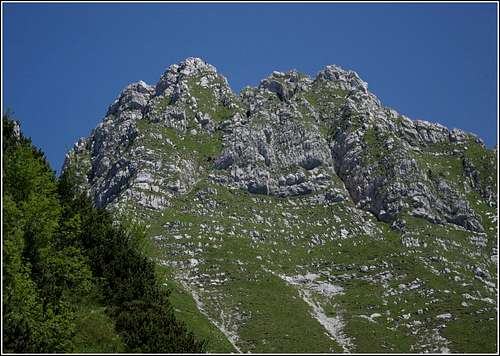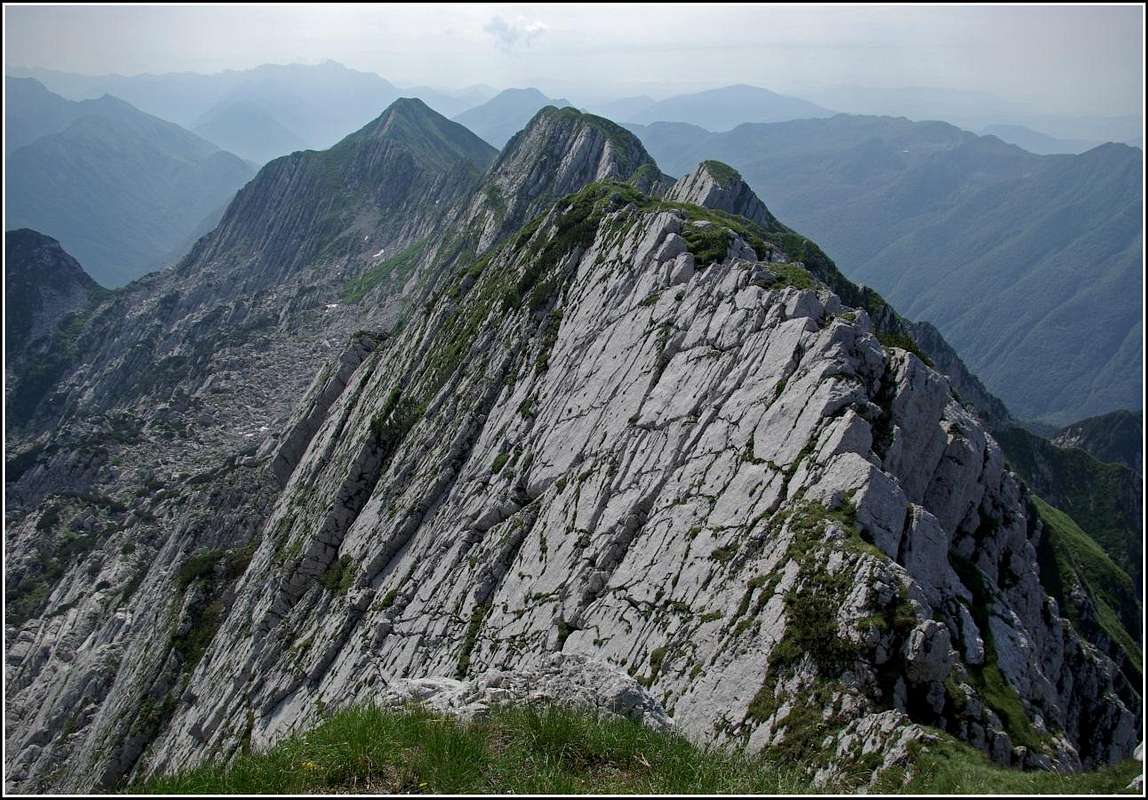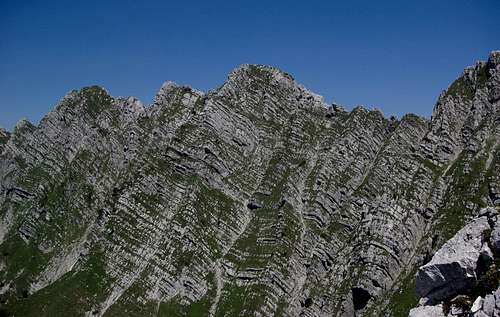|
|
Mountain/Rock |
|---|---|
|
|
46.32700°N / 13.29300°E |
|
|
Hiking, Mountaineering, Scrambling, Via Ferrata, Skiing |
|
|
Spring, Summer, Fall, Winter |
|
|
6161 ft / 1878 m |
|
|
Overview
As our fellow SP member Andrej Masera says in his book “Western Julian Alps”, the area dominated by the long ridge of the Musi seems to be one of the wildest of the whole alpine arc. The feeling of solitude and bewilderment that you feel while you go up on the very steep slopes of this mountains is really overwhelming. It’s an out of time place, frequented only by rare lonely hikers and mountaineers ( and speleologists ) in search of that wilderness that is always more difficult to find in our times.
If it is very rare to meet humans in this mountains, it’s instead very easy to meet wild animals that live in this area completely undisturbed. Steinbocks, chamois, foxes, badgers, stoats, marmots, wild boars, wild cats ,roe-deers, vipers are not difficult to see. There’s also a vast population of birds: eagles, falcons, owls, capercaillies, partridges and crows can also be seen quite easily.
This 6 km impressive ridge ( direction west to east ) is situated in the Julian Prealps, among the valleys Resia, dei Musi and Torre. The average elevation of the summits of the crest is around 1800 m, with the main summit Monte Musi that reaches 1866 m. The east summit is slightly higher ( 1878 m ). Monte Cadin ( 1818 m ), Monte Zajavor ( 1815 m ) and Viliki Rop ( 1869 m ) are not part of the Cime del Monte Musi, but can be considered summits of the Musi group.
The group of Monte Musi is mainly composed by three kinds of rock: Oolitic limestone, Dachstein limestone and Dolomia Principale, originated between 240 and 180 million years ago. Like its much more famous neighbor Canin group, is very interesting from the geological point of view. If you observe either the north or the south faces of the Musi ( that rise for more than one thousand meters above the picturesque villages of the Val Resia and above the canyon of the river Torre ) you can see all the stratifications originated by the glaciations and the erosion of the elements. All around there are impressive Karst phenomena and more than 200 deep caves have been found by speleologists.
This area is also known as the most humid and rainy of the Julian Alps but also of the whole country. The average annual rainfall is really exceptional, around 3300/3500 mm in a year. In 1960 the maximum amount of rain in one year ( more than 6000 mm ) in Italy has been registered in Uccea, on the eastern slopes of the Musi. So if you want to climb this mountain it’s better to choose a beautiful summer day with a cloudless sky , because if you see just a few clouds above the Musi it’s probably going to rain soon.
Beautiful the views from the summit: the mountains of the central and the southern ridge of the Canin group on the other side of the Val Resia, the whole group of the Julian Prealps all around, Jof di Montasio and Monte Cimone, the Krn group, the Sernio-Grauzaria group, the Zuc dal Bor group, the hills and the plains of Friuli Venezia Gulia and if the sky is clear also the Adriatic sea, the bay of Trieste and the Istrian peninsula.
Getting There
You can approach the Musi from Val Resia ( north ) or from Val del Torre/Val dei Musi ( south ).
From east ( Italy ): From the Udine Tarvisio motorway exit Gemona and then Tarcento – Val del Torre ( indications for Uccea/Slovenian border )
Or exit Carnia and then Resia-Sella Carnizza
From West ( Slovenia ): From Kraniska Gora or Tolmin to Zaga and then Uccea ,Val dei Musi or Sella Carnizza.
Panoramic views
 |
 |
 |
Routes overview
There are only two known routes to Monte Musi, very different but both very interesting and rewarding.
1)From Val dei Musi: For expert hikers, probably the best option but very hard because the path is very steep. Mini ferrata in the last part.
2)From Sella Carnizza: For expert hikers, shorter than the other but more challenging in the last very exposed part. Secured with iron ropes in the most difficult sections.
There’s a third path ( not indicated but there are some very old red marks that you can follow from Sella Carnizza ) to the Finestra naturale sui Musi ( natural window ) but it doesn’t reach the summit . It’s anyhow an interesting hike in a very strange karst environment.
There’s also the possibility to cross all the crests of the Musi from Monte Cadin to Monte Zajavor. It’s a very long and difficult route for expert alpinists with climbing equipment.
Monte Cadin: normal route from south ( From Musi, Alta Val Torre ), path n°740. For expert hikers, 6 hours.
Monte Zaiavor: can be climbed either from south ( Passo di Tanamea, 5 hours ) or from north ( St. Anna di Carnizza, 3 hours ). They are both easy hikes, path n°727.
Just before the saddle between the Musi and Viliki Rop there’s a path ( very old red marks ) that goes up on the north eastern side of the latter, but I don’t know if is a climbing or an hiking route.
Summit views
From the main summit:
From the east summit:
Red Tape
The Musi are inside the Parco Regionale delle Prealpi Giulie . There are no fees to pay or particular restrictions, all that is asked is the maximum respect for the flora and the fauna of this wild areas.
When to climb?
The best season is from May /June to October/November. On the northern slopes you can find snow until mid-June. The paths to the Musi can be very dangerous in wet conditions so it’s better to avoid to climb this mountains after heavy rains. In the winter ski-alpinistic ascents are possible.
Meteo
Friuli weather forecast
Accomodation
Monte Musi can be climbed in one day so it’s not necessary to spend the night in the area. There’s a bivouac near the summit that can be useful in case of emergency or if you want to try alpinistic ascents. It is dedicated to Dino Brollo, a local alpinist died climbing the Piz Bernina in 1991.
Either in Val Resia and in Val del Torre you can find good and cheap accommodation if you want to spend more days in this beautiful area.
Val Torre accomodation
Parco delle Prealpi Giulie accomodation
Maps and Books
Tabacco maps ( 1:25000 ):
020 Prealpi Carniche e Giulie del Gemonese
027 Resia-Monte canin
026 Prealpi Giulie-Valli del Torre
Books:
Alpi Giulie - Ettore Tomasi – Tamari Edizioni
Alpi Giulie Occidentali - Andrej Masera – Sidarta Edizioni
Il Parco delle Prealpi Giulie - Giunti Editore
Escursioni nel Parco Naturale delle Prealpi Giulie - Fabio Paolini – La Chiusa Edizioni
Luci e Silenzi nel Parco delle Prealpi Giulie - AFNI sezione FVG – Grafiche Risma













